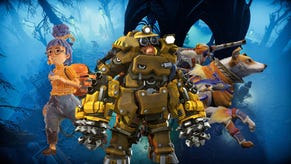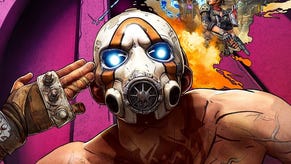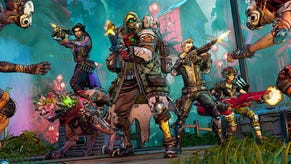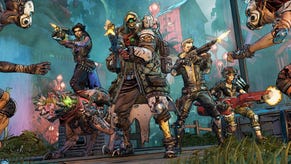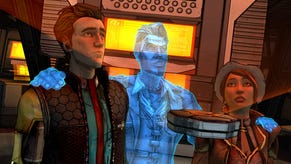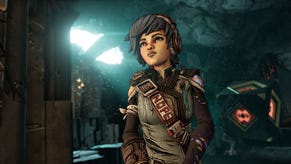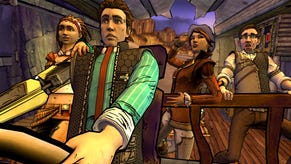Wot I Think: Borderlands 3
The real loot was the friends we made along the way
Twenty hours into Borderlands 3, in the jungle-drowned innards of a crashed starship, Moze finally opened up. Until that point, we only knew she was a war lass with a big mech. During a bit of scripted mission patter about awkward names, however, she revealed she was born Moserah Hayussinian Yan-Lun al-Amir Andreyevna, and we thought we were going to learn another precious fact about her.
Alas, she continued as far as “but” before she was interrupted. By a vulgar AI in the body of a teddy bear, that honked out “aw crap, more robots,” in a voice like an NYC rapper by way of Peter Griffin. And indeed, there were more robots. We had crossed the invisible line triggering their arrival, and the bear’s exclamation of dismay had to override Moze’s life story. Oh well.
We made the robots disappear by clicking on them a lot, and then it was on to the next encounter: a malevolent security AI that made horny space monkey sounds over the ship’s PA system, summoning waves of horny space monkeys to the room. They threw their shit at us. The bear said “aw crap” a lot more. Eventually, we clicked on the monkeys enough that it all stopped.
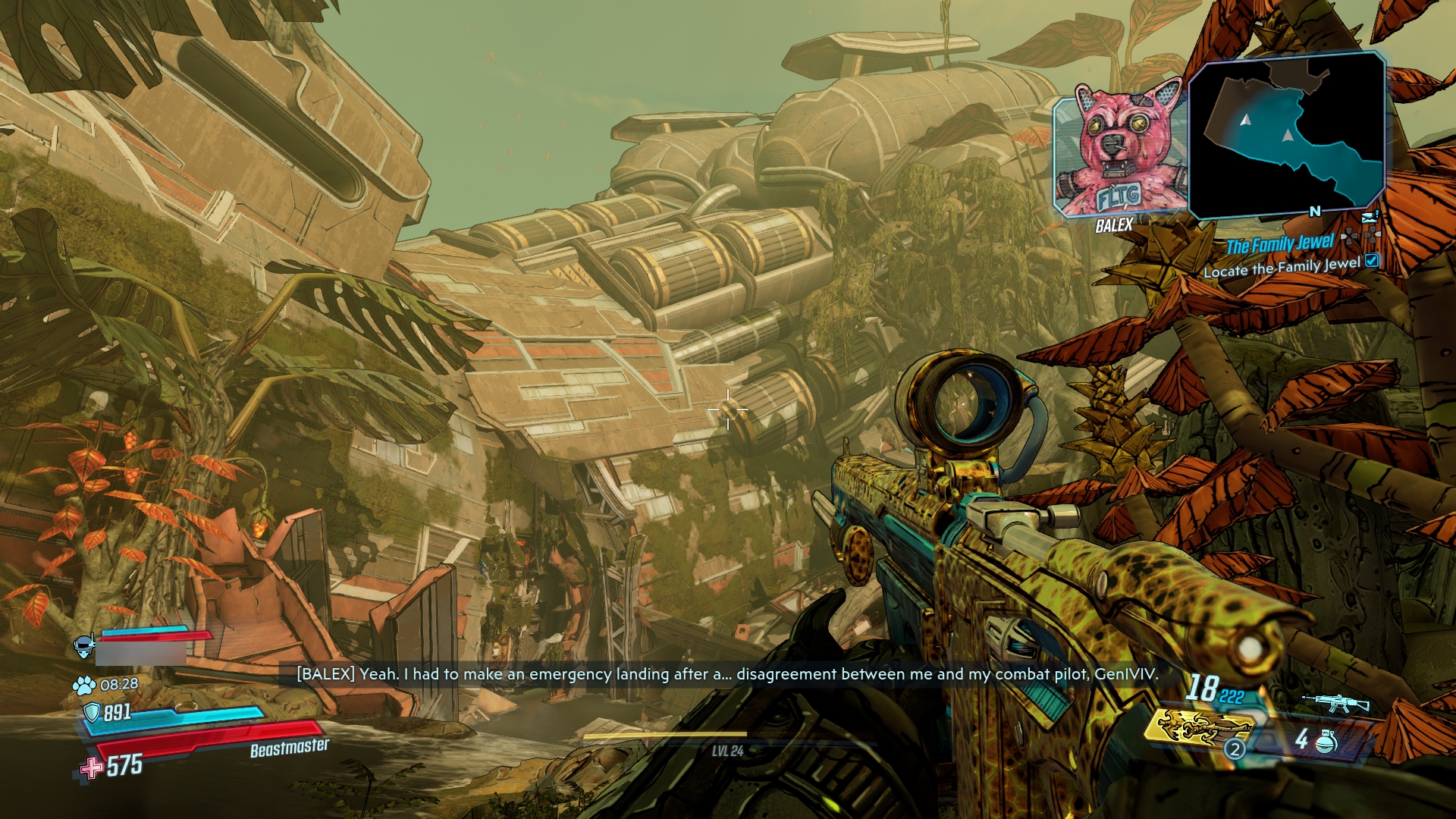
Burgerlords 3 is a game about clicking on things until they stop. It’s blessed with exquisite audiovisual design, it’s extremely annoying on several levels, and it’s compelling despite its boneheadedness. It takes a while to get up to speed compared with previous iterations, and it suffers from having missions stretched to the point of tedium for the sake of boasting a 30+ hour play time. But when it’s firing on all cylinders, it’s the most fun the series has been. At times, I even laughed out loud at the game’s script - which only made the rest of it, with all its dated meme references, poo lols and roaring bros, more frustrating.
Because we got review code after launch, you’ve probably already read a couple of reviews of Bonglungs 3 by now. This is quite a relief, as it means I don’t have to spend as much time saying the same things as them. To summarise: yes, it is a lot like 2012’s Borderlands 2. Yes, it is bigger in pretty much every respect. And no, it still hasn’t done much to update the series’ basic mechanics from ten years ago.
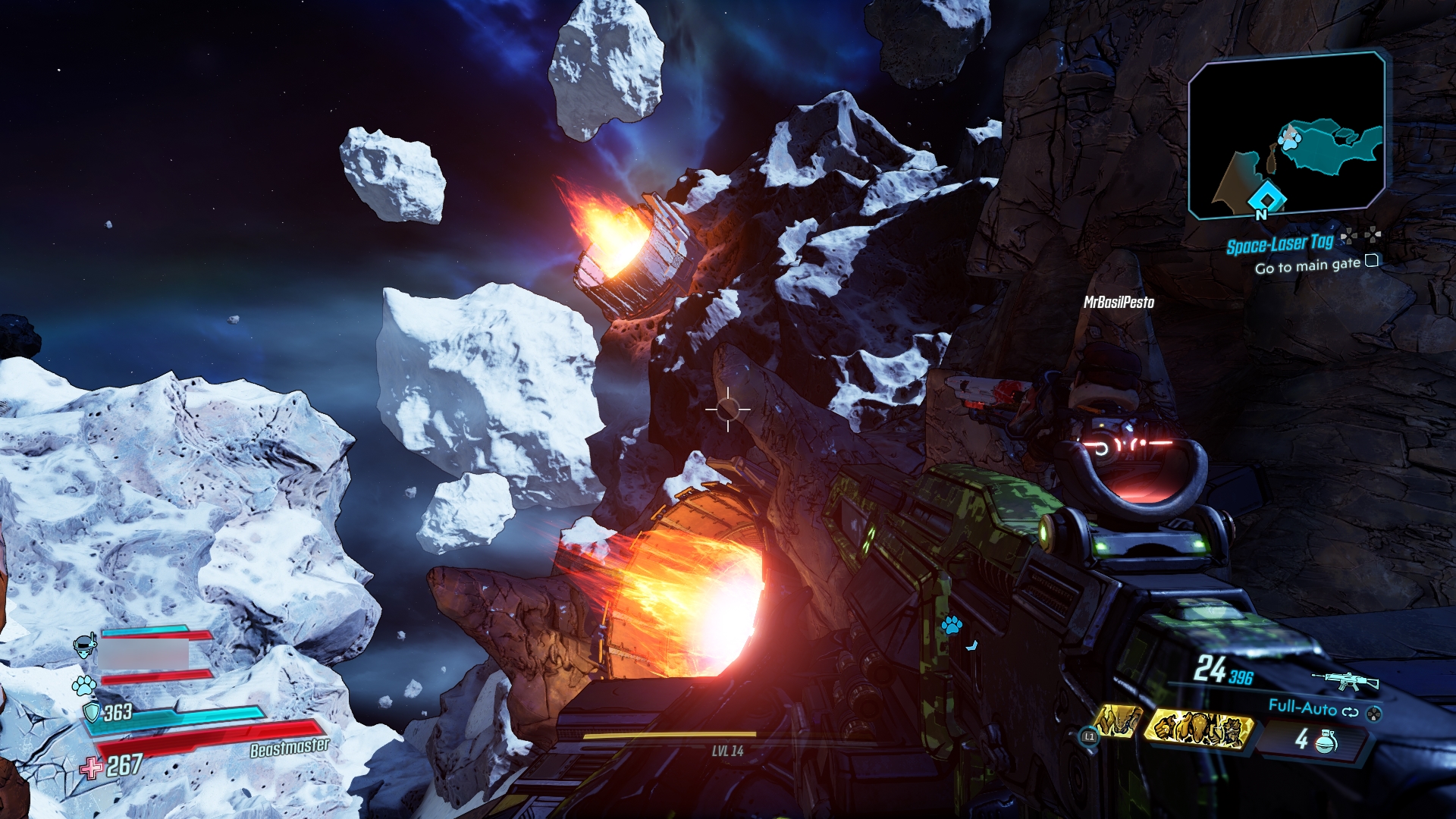
There are some new things. Vault hunters now each get a choice of three active abilities, with room for much more varied character builds, making total re-specs between missions both feasible and rewarding. There’s customisable vehicles, a new damage type (radiation), everyone gets the pre-sequel’s ground pound ability (I used it three or four times, however), and there are new traversal mechanics, for clambering around on corrugated iron sheds and that. And best of all, there’s now opt-in loot instancing, which can take away the irritation of squabbling with your co-op group over who gets the cool new sniper rifle from a boss drop.
There’s also a little more social conscience to it all. Although the game still finds dwarfism and schizophrenia hilarious, “midgets” have been replaced with “tinks”, and “psychos” at least now come in more than one gender variety. In fact, there’s a pretty reasonable gender balance among the named characters too; although we didn’t count, there seemed to be more women than men.
Even so, there’s a particular flavour of fierceness common to the game’s women (particularly antagonist Tyreen, who’s got a sort of Warhammer 40,000 Billie Eilish aesthetic), which suggests someone at Gearbox really wants their throat trodden on by a lady wearing twenty-hole doc martens and shouting scatological insults. Nothing wrong with that at all, but it definitely shines through.

Finally, there are the new planets, which are great. Although they’re functionally identical to the new biomes that appeared in Bundlebirds 2, the connecting device of having a firefly-esque spaceship as your travelling quest hub between them is brilliant, even if said ship’s interior is as easy to navigate as Embankment station after twelve pints.
After all, under the Gross Bros and Turds skin of the franchise has always lain a weirdly majestic bit of space fantasy, and I genuinely enjoyed poking round a few more of its corners. Infiltrating an asteroid-mounted orbital artillery piece during a siege war between two monolithic corporations, or getting to explore the ancestral, swampland mansion of the Jakobs company, was a thrill in a series usually preoccupied with running over dogs in a desert full of windmills.

But for every one thing that’s new, there are about twelve that aren’t. Conspicuously, some really basic limitations of the Borgleblood formula have been left untouched, and they’re looking even more outdated than they did seven years ago.
You still can’t track more than one quest at once on the minimap, which requires frequent maximising to navigate, and the game has a maddening habit of quietly changing which quest is highlighted, often leading to some confusing backtracking until you work out what has happened. Fast travel is a little bit of a ballache to execute, especially when you’re fatigued (as we were after mainlining the game for two days straight), and the whole business of gated play areas buffered with loading screens feels unusual for a game of this budget in 2019.
Inventory management is annoying and turgid, especially playing with a controller, and the game’s central, fetishistic obsession with BADRILLIONS OF GUNS is still hamstrung in execution by how much time you have to spend emptying your backpack to fit more in, before comparing rows of statistics and doing mental maths to work out which will throw out a bigger DPS, and thus earn a place in your hands. Apart from anything else, these sudden but unavoidable bouts of cigarette-packet maths really kill the flow of conversation with co-op partners, as you mumble numbers under your breath for minutes at a time in between fights.
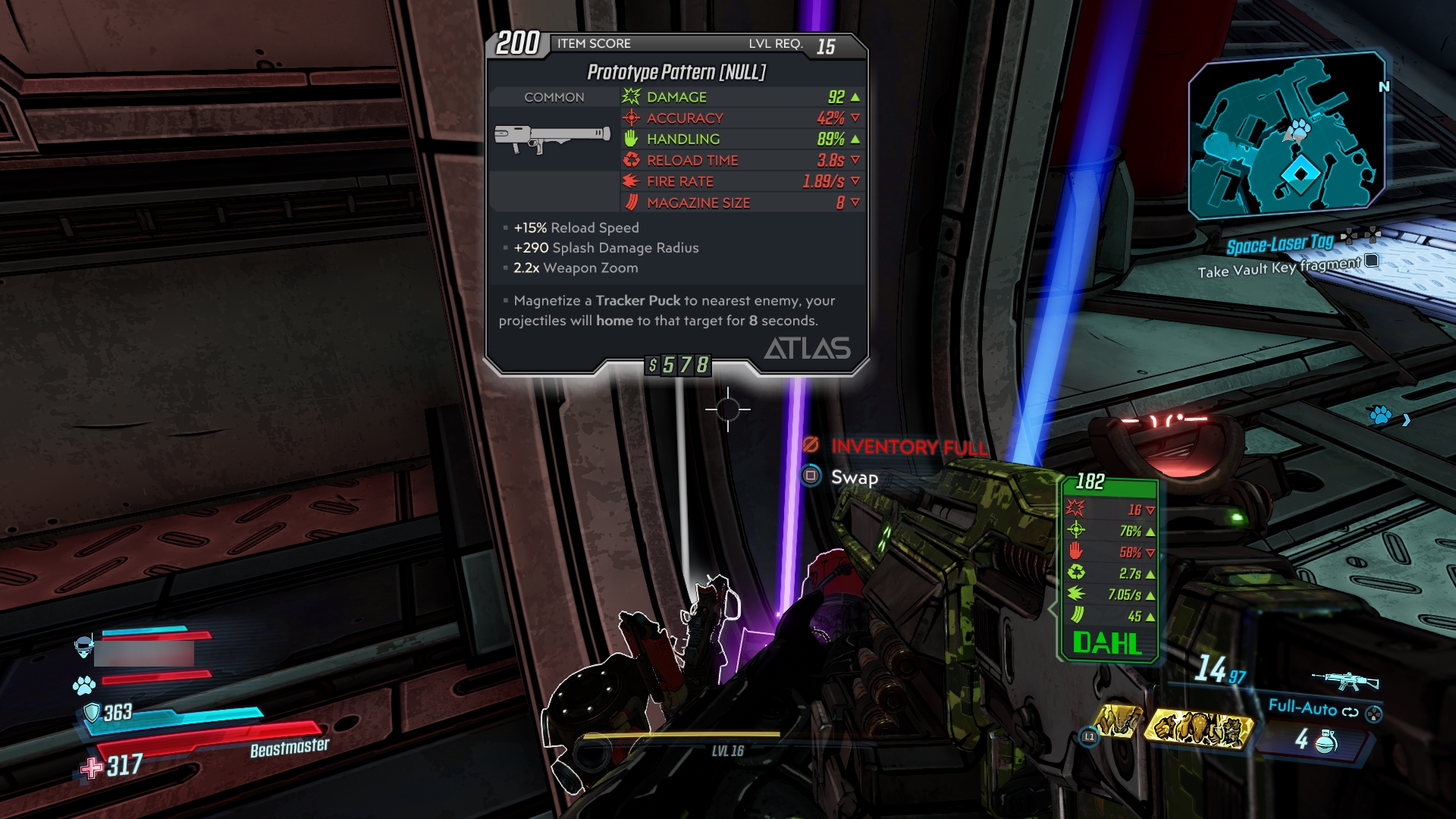
I’m not actually into guns much, either in games or in real life - they’re just not really my power fantasy. Even so, I can appreciate that the arsenal offered by Barterlead 3 is stunning, both in its variety, in the audiovisual design of the weapons, and the simulated experience of firing them. And yes, the rarer weapons do get just as weird as you probably hope they do, and more.
The problem is, there’s even odds that you won’t spend much of your playthrough actually wielding anything too kooky. Most of the time, I found myself using new and unusual weapons a few times to enjoy their gimmicks, before doing some Gun Maths and quietly acknowledging that some low-rarity revolver that fell out of a dead lizard’s bum would be far more efficient to carry on with.
Here’s where I stop circling the wheelbarrow of sausages at the heart of this review, and just dive in with gravy-slick hands: Borderlands 3 isn’t as wild as it thinks it is. Or as wild as it thinks you think it is, which is a crucial distinction to make. At the end of the day, it’s a game that struts around in burn-pocked, studded leather, proclaiming that big corporations are so evil and lame, while raking it in for a publishing behemoth that made two and a half billion dollars last year.
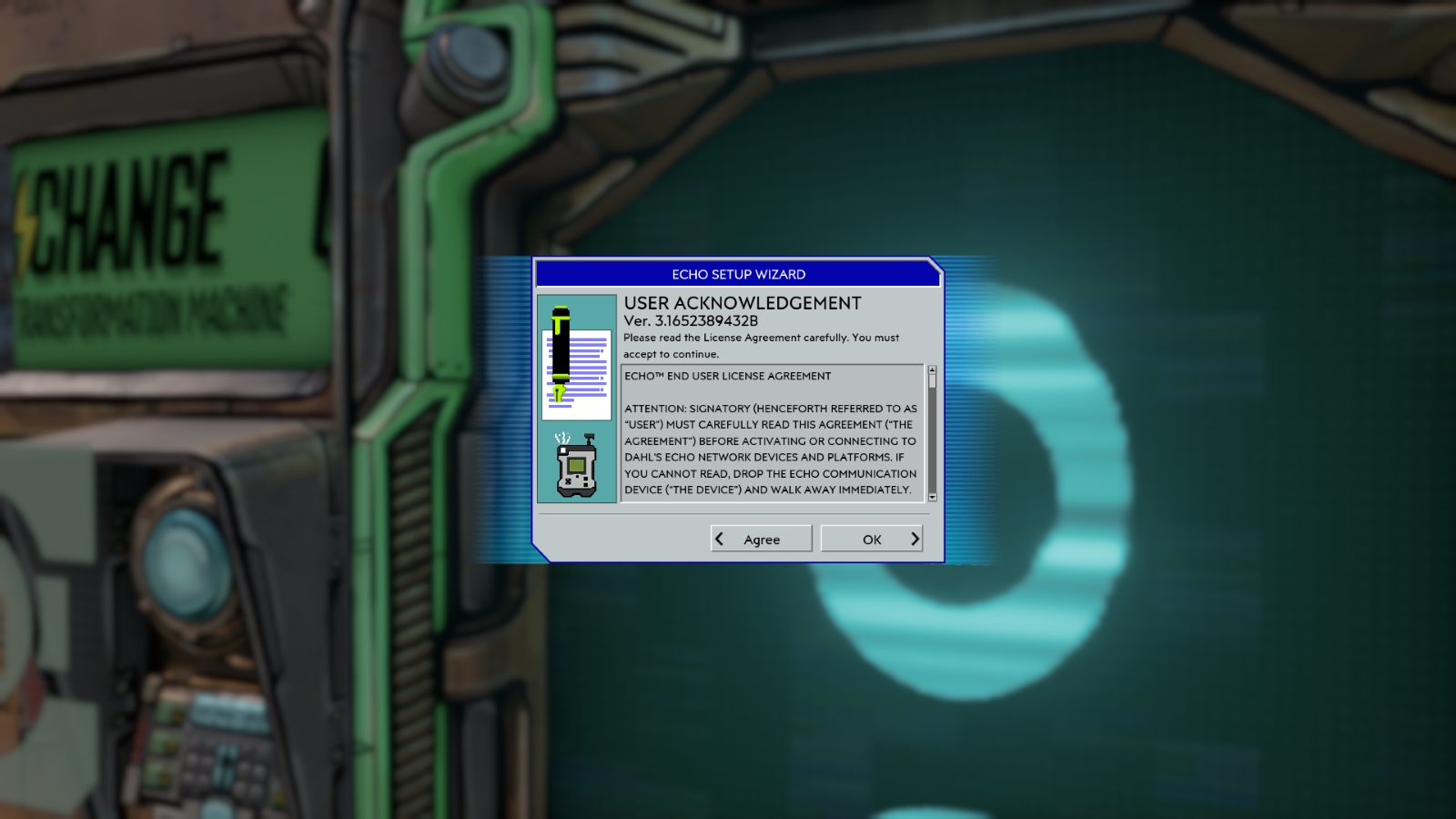
The poos-willies-bums-and-wee chuckles, the endless riffing on youtuber mannerisms, the repeated use of the word “badass”... It’s all a bit “how do you do, fellow kids?”; an uncomfortable nudge in the ribs from a series that really should be old enough to know better by now. In some fights, the game aids you by throwing in AI-controlled allies cameoing from previous games in the series - it was vaguely nice to see them again, I suppose, but I always got the feeling I was meant to be punching the air and whooping “HELL YEAH” at their appearance. Even a fucking bus got a lingering reveal shot.
This attitude extends to the basic substance of the game’s play, too. Bark-a-lark’s marketing has really focused on the concept of “mayhem”, but while they are certainly intense, the game’s many, many fights just don’t feel very… mayhemic? Despite a little experimenting with quest-specific weapons and mild puzzles, almost all missions boil down to big arena battles against mixed bags of opponents, and they pretty much all require the same spammy approaches to clearing them up.
When things get tough, it’s usually a lot easier to do a side mission or two in order to elevate yourself above the level of your opponents, than actually attempt any kind of tactics. I’m not saying this sort of fighting isn’t fun - it just isn’t particularly varied, unpredictable, or demanding of lateral thought.
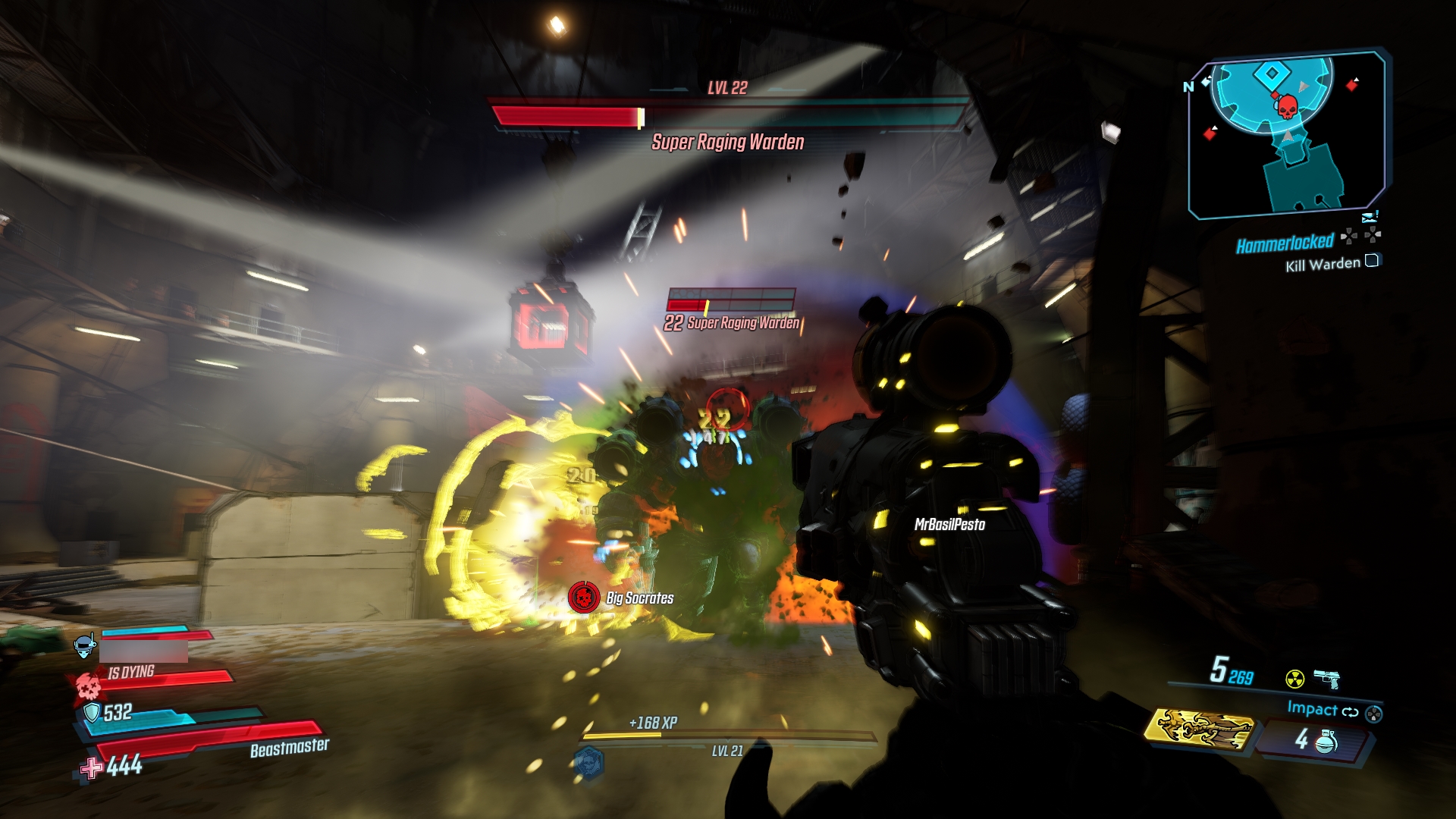
And it goes on and on. Straightforward missions are padded out with endless subsidiary tasks: at one point, we found ourselves deep in a series of three chained fetch quests nested within one part of a larger series of three chained fetch quests necessary to move towards a boss, and it felt pointedly desolate. Many times, we were allowed to think we were nearly done with a level, only for a “twist” to necessitate the accomplishment of a half dozen samey new tasks to get back to the same barrier to advancement.
And of course, there’s a further problem with this attenuated mission structure. Because every mission sees you corresponding (by radio or in person) with one of the game’s many characters, and every character has a Bit. Therefore, if you get stuck with a character who has a dud Bit, you know you will have plenty of time to get really, really tired of the joke being repeated. There were whole sidequests we just vetoed from the start, having heard four seconds of the introductory voice log and deciding we couldn’t bear the quest’s ‘host’ for a moment longer.
On this note, possibly my least favourite thing the game did to pad out its own script was when it would play a joke straight for about fifteen minutes (for example, the Tracer-sounding british guerilla fighter who’s Murderous Before She Has Her Coffee), then turn and wink at the player through the fourth wall about how contrived the joke was. When Coffee Lady pointed out that her whole character seemed based on weak “don’t talk to me til I’ve had a sip” jokes, I had a stab of the exact emotion I feel when someone explains one of my own jokes back to me on twitter. I think it’s called rage.

I will say this though - all the slogging involved in getting to the game’s boss fights only served to build anticipation for that end-of-a-chapter excitement, and the bosses themselves rarely failed to provide a suitable climax. There was one moment fairly on, where the likelihood of a giant monster battle was being telegraphed so heavily that I thought the game was certain to subvert it. When the giant monster appeared, blasting us with the best take I have ever heard on the cliche of “polyphonic alien howl”, I was overjoyed, and killing it was superb fun.
Although I’ve been quite hard on Bunglebouts 3, I want to carry on and finish on this positive note. Because despite having finished the game with a notepad scrawled full of irritations, I was surprised to find that I had enjoyed my two days of mainlining it more than I’ve enjoyed any time-intensive playthrough in a long while.
A big reason for this is that I was playing with chief RPS vidbud Matthew Castle, who is an extremely funny man to play a game with. But underlying that was the fact that, for all the Borderlands formula hasn’t changed much in a decade, it’s one that’s preternaturally well-optimised for co-operative play.
Level progression and scaling is handled so well it’s barely noticeable, while the aforementioned shallow tactical depth of combat becomes something of a welcome feature. If you do want to co-ordinate your tactics with a friend, even going so far as to spec your characters to compliment each other, it’ll make enough difference to feel rewarding. Equally though, if you just want to blast away together while talking about your favourite fruits, or how much a miniboss looks like John Cena after drinking eight gallons of Ribena, you won’t be penalised.
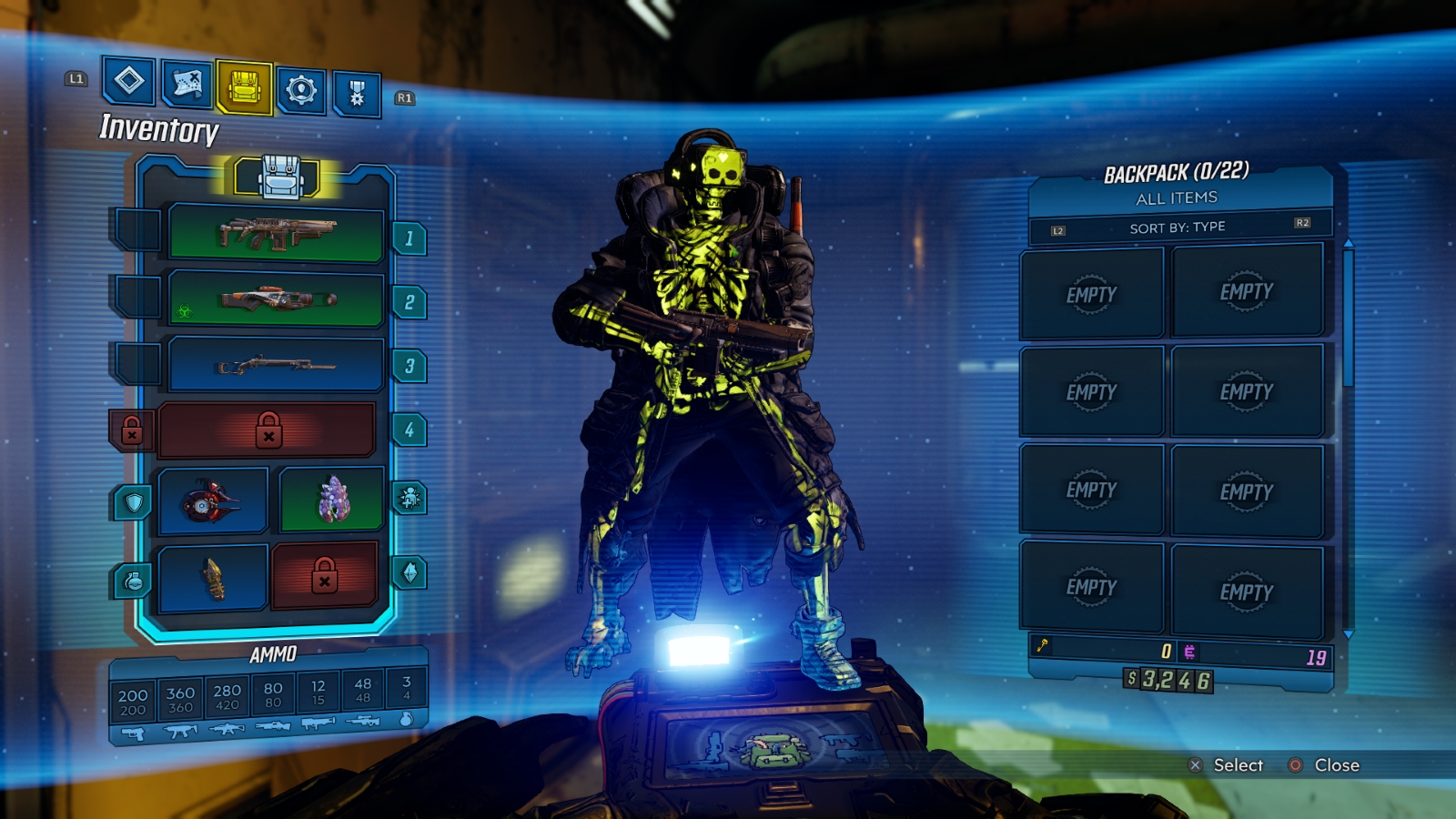
We spent a lot of time just chatting away as we trudged through the fights, and although our lack of attention meant we had to go a bit heavy on side-quests so as to stay ahead of the level curve and make battles more feasible for our level of focus, it was an approach the game was perfectly comfortable with. Indeed, in this context, the game’s repetition of plot points (and, indeed, jokes) makes a lot more sense, as one can imagine the designers assumed players would talk over much of it.
At one point, Matthew missed an incredibly important character death because he was out of the room, and I feared I would have to explain what had happened to him while we were knee deep in a fight - but my worries were for nothing, because the characters recapped the scene in intense detail maybe six times over the next hour of play.
Even the jokes that fell completely flat provided us a certain amount of mirth, as we made our own fun finding increasingly vitriolic ways to “celebrate” the popping-up of hated characters on the radio, and came up with mean clapbacks to their every bellowed catchphrase.
Blastyloot 3’s story goes on a lot about the old narrative chestnut of found family, and how the people you choose to hang out with can be more valuable, more special to you, than the people you’re obligated to feel a connection with by circumstance of birth. The game never really did anything with that theme other than mention it a lot, but I wonder if perhaps it made its most concise point accidentally. While the game itself isn’t the most stellar company, there’s no denying why it, like its predecessors, will be incredibly successful - because it provides a superb environment for hanging out with your pals.
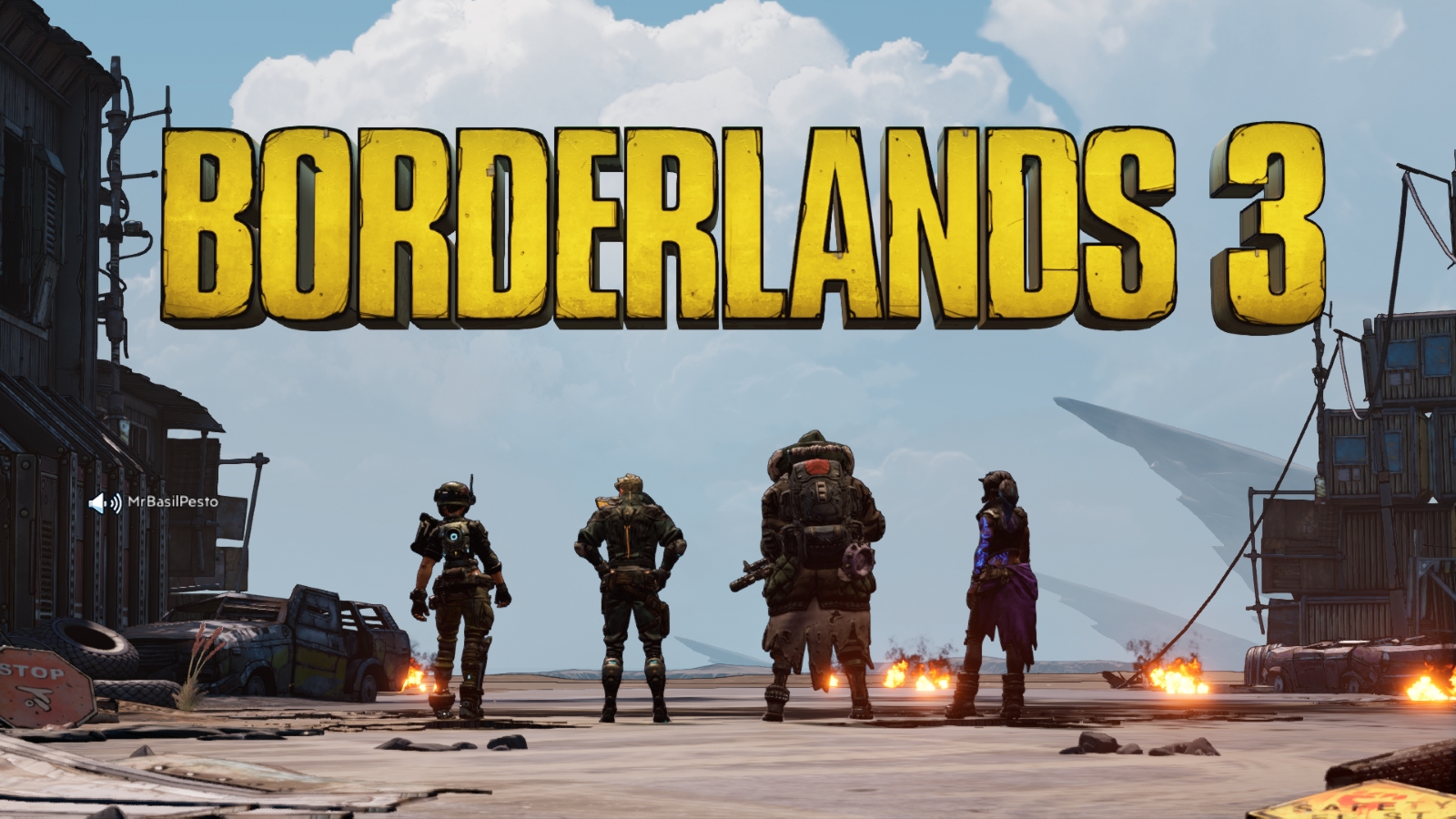
To conclude, I’d like to offer you a glimpse into the true meaning of friendship, as Matthew and I were taught it under the benevolent guidance of Brute-a-lot 3. Playing as the beastmaster robot, FL4K, I got to choose an alien pet to follow me through the game. Needless to say, I chose the massive ant thing, and over the time we spent in Pandora and beyond, that ant became incredibly special to me. Say what you will about Borderlands 3, it introduced me to one hell of an ant:
(The video is NSFW but only because it's quite swearish. There's no sexy ant bums or anything. Credit goes to Matthew Castle for this moving tribute.)



